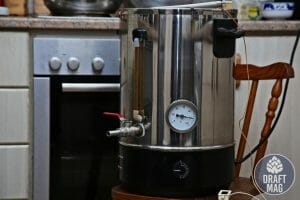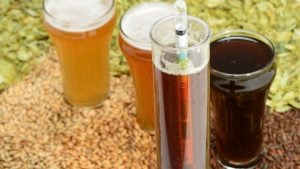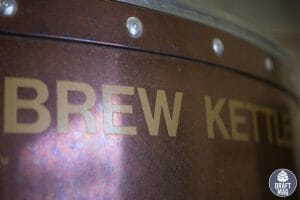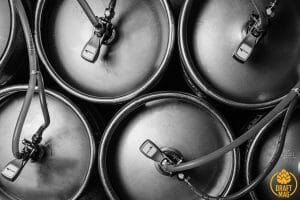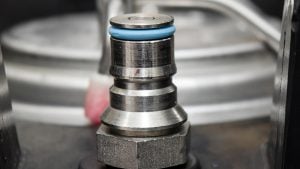What Is a Foeder: What Does It Really Do and Why Is It Widely Used?
 You might have asked yourself, “What is a foeder?” if you’ve ever been in a brewery. During a beer tour at some breweries, you will most likely see a room with stacks of barrels, and those are called foeders.
You might have asked yourself, “What is a foeder?” if you’ve ever been in a brewery. During a beer tour at some breweries, you will most likely see a room with stacks of barrels, and those are called foeders.
The equipment produces some of the most unique and popular beers today, and we will explore them in this guide. We will also explore the best beers made with a foeder and how this equipment really works.
What Is a Foeder?
A foeder, pronounced “food-er,” is a large, wooden fermentation vessel that looks very similar to a barrel and is made up of a series of oak staves put together with metal hoops. The name originates from the Dutch word for a big wooden tank, called “vat.”
All About Foeders
Foeders were historically meant for winemaking, but today, they are becoming very popular with American craft breweries. The French will call it a “foedre,” but it all means a large oak tank for fermenting beer.
– Origins
Foeders were adapted from the practice of winemaking. They were used to store wine but are now used to ferment wild and clean beers. Many brewers use the foeder to make their wild beers more robust, complex, and fruity.
Since they are large, the final product of the beer will taste more consistently than if you did the same thing in smaller barrels. It is also easier to work with one large foeder than a couple of barrels.
Foeders also have a larger surface area between the wood and the beer. This means the beer gets more oxygen and can age. But when the foeder is big, the oxygen level is low. This slows down the aging process and leads to consistency in the style profiles.
– Features
Foeders have different features like the levels of toast and the design. Modern foeders are now being advanced to have different features that would be helpful to the brewers. These include:
- Blow off ports
- Tasting ports
- Clean-in-place arms for efficient cleaning
- Chilling plates for adjusting the temperature
- Tasting ports
A brewer can decide to choose a foeder with a lot of toast on the oak. The more the toast is, the more hints of vanilla, roasted and charred characters will end up in the beer. Heavy toast is ideal for some kinds of beers, while the lighter toast is preferred for others.
Material
Historically, a foeder maker constructs the foeder. Types of wood include French oak, cypress, and others, but American manufacturers today usually hire a cooper, which is someone that builds barrels, to make a foeder for them. It takes about 40 hours to build a foeder out of standard Missouri white oak.
The foeder is usually made with American white oak and then blended with French oak, but this depends on the needs of the brewery. A foeder maker, on the other hand, can make a foeder using a wide range of techniques and is not limited like the cooper.
Some foeder makers can construct this equipment with a manway that gives access to the interior of the foeder for cleaning. But this can also cause less structural integrity because the foeder will have shorter valves.
When constructing a foeder, the foeder maker keeps all these factors in mind to build one that is reliable and still meets the needs of the brewer. This is especially important with very large foeders because the size can affect the oxygen allowed into the beer.
Size
Foeders usually start at 165 gallons or five bbl., and they can be as large as possible, depending on the brewery. The largest foeder in the world was built in France, and it was as large as 264,172 gallons or 1,000,000 liters.
Foeders are designed to take up less space in a storage room than a normal oak barrel, but they will still have the same value. It’s no wonder why brewers are always eager to get one, as they are more efficient.
Foeders come in different types of sizes, from 7 bbl. and 15 bbl. to 200 bbl.
Form
The form of the foeder is based on the preference and intent of the brewery. Foeders can be horizontal or vertical, and there is no fixed shape. When it’s horizontal, they are usually used to brew lagers because there is a short distance that allows the yeast to fall out.
But a vertical or long foeder will provide a higher wood surface-to-bear ratio, which means there will be more oak in the beer. Some brewers even go for a conical bottom foeder, which is ideal for harvesting yeast and cleaning out the fruit.
So breweries decide on the form of the foeder based on their needs and the space that they have available.
Toasting
Yes, foeders get toasted and charred like they do with oak barrels for wine. Breweries usually go for a toasted and charred foeder, and it is very rare when one does not request this from the cooper. This will mean that they don’t want the sharpness or spiciness offered by raw oak in their beers.
When making foeders, the cooper or foeder maker can use oak that has been air-dried for about two years. Then, it would be steamed after being built to remove the tannins and hydrated. The interior of the foeder will be toasted or charred based on the specifications provided by the brewery.
– Barrel vs Foeder
What separates a barrel from a foeder is the size. There is no official size designation for defining a barrel and a foeder, but most brewers use the same rule of thumb. This states that if it’s larger than 160 gallons, it’s a foeder, and if it’s smaller than that, it’s a barrel.
Why Use Foeders
Barrel-aging has become a widespread practice among craft breweries and is known to produce top beers, but foeders have a clear advantage over barrels. When you make a beer with a foeder or a barrel, some of the properties are the same, but a foeder has certain pros in the beermaking process and the beer itself.
For one, a foeder can store more beer and take up less space. Foeders are built to hold large amounts of beer lately, but they are still three times larger than the standard beer barrel. This means that breweries don’t have to rack and manage multiple barrels.
Aside from saving space and time, foeders reduce the chances of cross-contamination caused by bacteria and yeast compared to barrels. This is because they can store a large amount of beer at a time. In terms of the beer, a foeder gives the beer time to mature slowly and develop fully.
Oxygen can get through a foeder but very slowly, which is called ingress. This ensures that the beer meets the style profile needed by the brewery. It also infuses the oaky character into the beer at a slow and less-intense rate. Finally, you can expect consistency in flavor and aroma when using a foeder.
– Best Foeder Beers
If you’re curious about what foeder beers taste like, you can always visit the breweries mentioned below to purchase one or buy yours online. Some of these breweries offer their foeder beers for purchase and delivery, and some online beer stores also have them in stock.
– La Folie by New Belgium
 One of the best Flemish sour beers in the world that is made with a foeder is the La Folie. It is brewed by New Belgium in Colorado and will make a great introduction to the world of foeder beers.
One of the best Flemish sour beers in the world that is made with a foeder is the La Folie. It is brewed by New Belgium in Colorado and will make a great introduction to the world of foeder beers.
The Flemish brown beer has hints of vanilla, tart green apple, and lightly toasted bread in its style profile. All of this is blended to make an approachable sour ale. The brown ale is first fermented in a stainless container and then transferred to foeders, where it can age for up to four years.
It has a 7 percent ABV and will give you just the right amount of sour. It pours brown with minimal head, and the aroma and flavor are dominated by oaky tannings and dark fruit.
– Galaxy White IPA by Anchorage Brewing Company
You can also go for the Galaxy White IPA by Anchorage Brewing. This is especially true if you’re curious about what an Indian Pale Ale becomes after being fermented in a foeder. The beer is first brewed with Galaxy hops, kumquats, coriander, and peppercorn.
It is then fermented with Brettanomyces in the French oak foeders, leaving you with a juicy and complex flavor profile. In the end, the beer is bottle conditioned. It features a 7 percent ABV and a light, champagne-like body.
The Galaxy White IPA pours pale yellow with a foamy head and offers hints of fruit, bread, grass, peach, kumquat, and lemon in the taste and aroma. You will also notice some earthy and herbal hints.
– Grand Cru by Rodenbach
The Grand Cru is known as the standard on which other Flemish red ales follow. It is made by Rodenbach, known for its long history of brewing foeder beers. You can expect impressive consistency and high quality in the beers.
The Grand Cru ale is an oaky, rich sour beer with a sharp, vinegar-like finish. The aroma and flavor are dominated by the flavors of cherry fruitiness and tartness. This is backed up by a complex mix of raisin, orange, dark chocolate, caramel, and vanilla.
It pours a clear amber body with a firm and foamy head. The medium-full mouthfeel and average carbonation give the tartness a crisp feeling in your mouth.
– Foeder Cerise by American Solera
We also recommend the Foeder Cerise to those who want to enjoy an authentic foeder beer. It is brewed by American Solera. The brewery is well-known for making their American versions of Belgian-style mixed-fermentation ales. The brewery has been using foeders since 2016.
The Foeder Cerise beer is aged for six months in the foeder with Brettanomyces and Montmorency cherries, so it’s not surprising that the beer tastes like cherry pie. It has a deep red, funky and sour character.
It features a 6 percent ABV and is not aggressive in the tartness or sweet flavor. The cherry pie and clove spice are evident in the aroma. Also, the carbonation will later flatten the cherry flavor in your mouth.
– Vat Series by Brouwerij Boon
Foeder beer also tastes great when it’s made by Brouwerij Boon. This is a popular Belgium-based brewing company. They are known for their Lambic brews. These are spontaneously fermented beers, and they age the brews with wild yeast in foeders.
You can go for the Vat Series, which consists of a wide range of beers. It offers an amazing experience, especially if you want to know how beer fermented completely in one foeder will taste. For complex characters, go for Vat 109 or Vat 77.
– Other Top Foeder Beers
You can also give these foeder beers a try, especially if you want something from the USA.
- Alice (Blend #3) by Green Bench Brewing
- Lovely Bubbles by Green Bench Brewing
- Good Luck! by City Barrel Brewing
- Nec Bones by Firestone Walker Brewing
- Saison de Banc Vert by Green Bench Brewing
- Peach Foundation by City Barrel Brewing
- Mira (Blend #1) by Green Bench Brewing
What Breweries are Using Foeders?
Breweries that make Flemish sour beers are renowned for using foeders, with Rodenbach leading the pack. The brewery is globally popular for using foeders, as they have been doing so since 1821 to make classic Flemish red beers. Other Lambic brewers in Belgium like Lindemans and Boon also use foeders to make their beer.
Foeders have also become very popular in the United States, with the number of breweries catching on increasing. Colorado-based New Belgium Brewing was among the first breweries in the USA to use foeders in fermenting their beer. This brewery is one of the largest foeder beer makers in the country.
Here are some other top breweries in America that use foeders:
- Anchorage Brewing
- Bearded Iris
- Crooked Stave
- American Solera
- Deschutes
- Wicked Weed
- City Barrel Brewing
- Green Bench Brewing
– What Types of Beer Do Brewers Make in Foeders?
Normally, brewers make mixed-culture fermentation beers in foeders. This is a type of beer that uses a mix of bacteria and yeast to ferment the beer, and it goes well with the design of a foeder.
For example, breweries use foeders to make sour beers and wild ales. These give them a more complex and wood-aged character in the beer than what they get with a kettle of sour ale. The beer can be aged for up to a year and will allow very small amounts of oxygen in.
Another type of beer that brewers can make in foeders is the Saison. An example of a brewery that does this is Green Bench Brewing, and the facility has a foeder as large as 25 hectoliters. When making their Saison, they keep the yeast in the foeder without repatching or cleaning. This allows the yeast to colonize and spread into the foeder.
Foeders can also be used to brew farmhouse ales, Flemish-style ales, and even spontaneously fermented beers.
What’s in Store
Demand for foeders has continued to increase in the past years. Companies like Foeder Crafters have opened to make these barrels for breweries. Nowadays, foeders are not only used to make sour beers and mixed fermentation ales.
Breweries have expanded the use of foeders and are now using them to make clean beers. Clean beer means the lager or ale is fermented with only one strain of yeast. Foeder makers specifically add a cooling plate to the equipment when it is meant for clean beers.
It is expected to see this brewing technique become more advanced in the future. Brewers are now using foeders traditionally and for more modern uses.
Frequently Asked Questions
– How Do You Clean a Foeder?
Foeders are usually cleaned with hot water and citric acid. This is cycled through the spray ball, making it easy to clean. Some breweries will also cycle oxygen bleach or alcohol through the spray ball to clean it, then you can sanitize the tank with steam to prevent bugs.
A foeder can last for over 100 years if it is well taken care of and cleaned regularly. They are usually built for long-lasting use and durability.
– What Is a Coolship Beer?
A coolship is a large open vessel meant for cooling wort before fermentation. It is not the same as a foeder, which is used for fermentation. The coolship is usually used before spontaneous fermentation.
Conclusion
The next time you visit your favorite brewery and see a large stack of barrels, now you know that it’s a foeder. Some of your favorite beers probably come from that equipment.
 A foeder is a large, wooden fermentation vessel, usually over 160 gallons.
A foeder is a large, wooden fermentation vessel, usually over 160 gallons.- Foeders are made by coopers or foeder makers to the specification of the brewery.
- Foeders are as small as 5 bbl. but can be as large as required.
- Foeders offer different benefits over barrels in terms of space efficiency and slow fermentation.
- Foeders are usually used to make sours and mixed-fermentation beers.
It’s always a good idea to try something new, and foeder beers are a great place to start. The practice is evolving every day, which means there is a wide range of beers that you can purchase which have been fermented and aged with foeder.

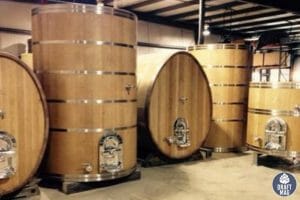 A foeder is a large, wooden fermentation vessel, usually over 160 gallons.
A foeder is a large, wooden fermentation vessel, usually over 160 gallons.